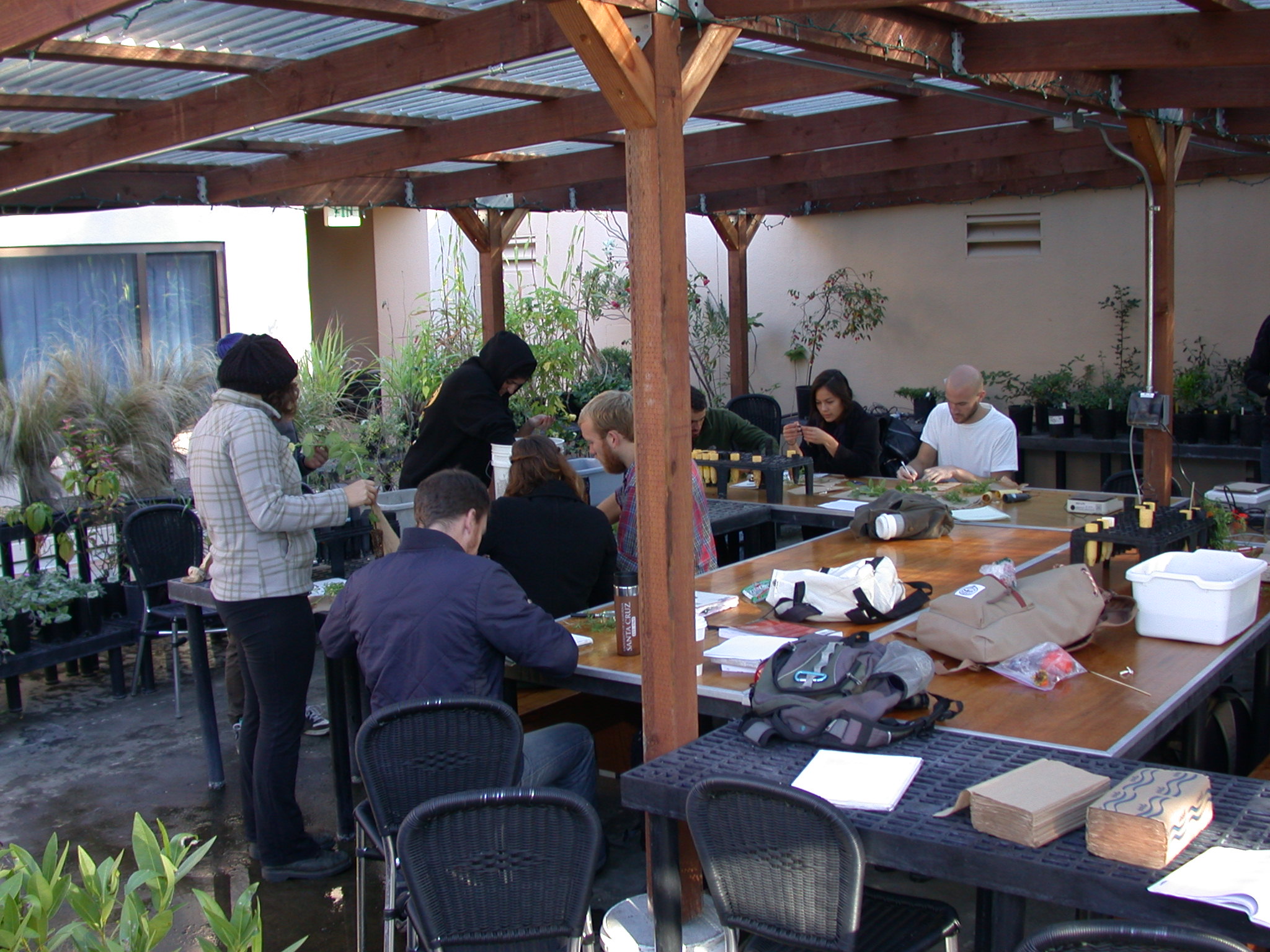Instruction
Five greenhouses, outdoor seating areas and a lab hold a collection of diverse plants from around the world. Our labeled botanical collection is comprised of over 700 species of plants with an emphasis on ethno botany, systematic botany, evolution and ecology.
There is a large lab that can accommodate classes up to 38 students. Displays are set up for many classes to facilitate comprehension of complex lecture topics. Classes, discussion sections or TA office hours can be scheduled throughout the year. Wireless Internet access (Wi-Fi) and a small library of books related to plants and plant science complement the facility. If you would like your class to meet here, please contact Jim Velzy. Small groups or individuals are welcome anytime. We are open throughout the year, weekdays from 9:00am to 3:00pm, for students, faculty and staff to enjoy and learn. To get on the roof of Thimann labs, take the stairs on the west side of the building. (directions)
OPPORTUNITIES FOR STUDENTS
The UCSC Greenhouses sponsors internships and volunteers. Volunteers can work on restoration projects or other areas that may interest them. Internships vary as to their content as they are usually student designed. We are open to suggestions on possible topics, so stop by and strike up a conversation.
We have a crew of four students who work about 10 hours per week at the UCSC Greenhouses taking care of plants and facility maintenance. These positions are posted on the Career Center web site in the beginning of Fall (about a week before classes start) and end of Spring quarters (usually around the first week of May). Find out more about student opportunities here.
All students whether or not they are in plant related classes are encouraged to visit the facility to discover the interesting, exciting and diverse plant collection. We are also a wonderful place to study on Science Hill.
THE PLANTS
Our California plant collection is primarily plants of the Santa Cruz area but also encompasses plants from the entire state. These plants are used by students studying various topics including taxonomy, ecology, evolution and anthropological aspects of our local natives. The California plants are grouped together and are labeled with their genus, species, common name and plant family.
The plants in our evolutionary important collection are extremely diverse. We have plants that are represented by all of the major plant classes, Bryophytes, Seedless Vascular Plants-Psilophyta (Whisk Fern), Lycophyta (Fern Allies), Sphenophyta (Horsetails), Pterophyta (Ferns), Gymnosperms- Ginkgophyta, Gnetophyta, Cycadophyta, Coniferophyta, and Angiosperms (Flowering Plants). Some, like the welwitschia, are extremely fascinating. This plant grows in the Nimibian Desert, an area of the earth that receives less than two inches of rain a year. It has only two leaves and can live for over a thousand years in this harsh environment. These plants are used by students studying evolution and the various unusual adaptations plants have evolved to survive in extreme environmental niches.
We have a large collection of carnivorous plants. These plants are our biggest draw. There are many ways that these plants catch and digest their prey. They are extremely beautiful and bizarre.The Sarracenia or pitcher plant is pictured showing its pendulous flowers and pitcher shaped leaves.These plants inhabit the area from South Carolina well into Canadian territories.
Our tropical greenhouse has many plants found in rainforests around the world. Chocolate trees, Allspice, vanilla, coffee, tea, ginger, and pineapple are just a few of the many plants on display. Students studying ethnobotany have a valuable resource available for them here on the rooftop.
We also have Myrmecopilous plants. These are plants that have a symbiotic relationship with ants in the wild. These plants provide housing and sometimes food to the ants in exchange for protection. Ants will guard these plants fiercely if the plant is in jeopardy of being eaten. We do not have the ants at our facility because many are biting and stinging ants that are illegal to import into the US.
We have three ponds on the Thimann roof full of aquatic plants. These areas provide us with a wider variety of plants for use in courses such as Systematic Botany and Freshwater Ecology. We recently installed a replica of the Moore Creek Watershed. This babbling waterfall is powered by a solar panel. The Student Environmental Center (SEC) sponsored this project to highlight the importance of our watershed here on campus.
We grow many plants for restoration projects on the main campus and UC Reserve land. These plants are used by the UCSC Natural Reserves, UCSC Site Stewardship Program and by campus facilities. Students work through independent studies, internships and volunteer work to grow the plants, monitor local habitats and establish these plants in the field. To find out more on this, visit our restoration page .
Additional plant groupings are:
Aquatic plantsBromeliadsCactus and succulentsEpiphytesHerbs and SpicesMedicinal plantsOrchids
TOURS
Tours are given by special arrangement. Contact us at greenhouse@ucsc.edu to make arrangements.

